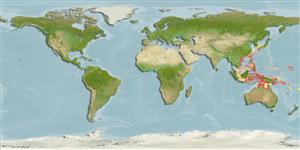>
Gobiiformes (Gobies) >
Gobiidae (Gobies) > Gobiinae
Etymology: Asterropteryx: Greek, a = with + Greek, sterros, -a, -on = consistent + Greek, pteryx = fin (Ref. 45335); ovata: Name from Latin 'ovata' meaning egg-shaped, refers from the large ovoid black spot on the base of caudal fin.
Environment: milieu / climate zone / εύρος βάθους / distribution range
Οικολογία
Θαλασσινό(ά) βενθικό(ς); εύρος βάθους 15 - 40 m (Ref. 75136). Tropical
Western Pacific: Sulawesi (Indonesia) and Ponape (Caroline Islands), including Japanese waters; probably more widely distributed in the area and the Indian Ocean.
Μέγεθος / Βάρος / Age
Γεννητική Ωρίμανση: Lm ? range ? - ? cm
Max length : 2.7 cm SL αρσενικό/απροσδιόριστο; (Ref. 75136)
Short description
Κλείδες προσδιορισμού | Μορφολογία | Μορφομετρία
Ραχιαίες άκανθες (συνολικά) : 7; Μαλακές ραχιαίες ακτίνες (συνολικά) : 9 - 10; Εδρικές άκανθες: 1; Μαλακές εδρικές ακτίνες: 8 - 9. This species differs from the other species of the spinosa complex in having the following set of characters: cheek spines 3-6; largest cheek spine slender obviously longer than other spines, length 2.6-6.3% SL; a pupil- or eyesized ovoid black spot on base of caudal fin (extending anteriorly to third mid-lateral scale before posterior margin of hypural); head, body and dorsal fins when alive or fresh has numerous orange speckles; first dorsal fin with no distinct black spot (Ref. 75136); characterized further by having prolonged fourth dorsal spine, forms long filament in adult; longitudinal scale series 22-24; ctenoid predorsal and body scales; cycloid scales in cheek, opercle, pectoral-fin base and prepelvic area; rounded caudal fin; depth of body 3.2-3.7 in SL (Ref. 90102).
Body shape (shape guide): elongated; Cross section: compressed.
Occurs in coral-reef slopes in the protected bays, found solitary on muddy or sandy-mud bottoms with dead-coral rubbles under the heavy growth of corals (Ref. 75136).
Life cycle and mating behavior
Γεννητική Ωρίμανση | Αναπαραγωγή | Γεννοβολία | Αβγά | Γονιμότητα | Προνύμφες
Shibukawa, K. and T. Suzuki, 2007. Two new species of the cheek-spine goby genus Asterropteryx (Perciformes: Goiidae: Gobiinae) from the western Pacific. Bull. Natl. Mus. Nat. Sci., Ser. A, Suppl 1:109-121. (Ref. 75136)
IUCN Red List Status (Ref. 130435: Version 2025-1)
Threat to humans
Harmless
Human uses
Εργαλεία
Special reports
Download XML
Διαδικτυακές πηγές
Estimates based on models
Preferred temperature (Αναφ.
123201): 25.3 - 29, mean 28.2 °C (based on 54 cells).
Phylogenetic diversity index (Αναφ.
82804): PD
50 = 0.5020 [Uniqueness, from 0.5 = low to 2.0 = high].
Bayesian length-weight: a=0.00724 (0.00339 - 0.01546), b=3.10 (2.92 - 3.28), in cm total length, based on LWR estimates for this (Sub)family-body shape (Ref.
93245).
Τροφικό Επίπεδο (Αναφ.
69278): 3.3 ±0.4 se; based on size and trophs of closest relatives
Ελαστικότητα (Αναφ.
120179): Υψηλό, ελάχιστος χρόνος για διπλασιασμό πληθυσμού < 15 μήνες (Preliminary K or Fecundity.).
Fishing Vulnerability (Ref.
59153): Low vulnerability (10 of 100).
🛈
